Common Blood Chemistry Test
What are blood chemistry tests?
Tests performed on blood sample to measure the amount of certain analytes in our body
involve electrolytes, proteins, enzymes, hormones, vitamins, minerals, lipids and glucose
provide important information on the function of kidneys, liver, heart, and other organs
used for screening and diagnosis of various human diseases, as well as treatment monitoring
Lipids (fats)
organic, nonpolar compounds
mainly composed of carbon-hydrogen (C-H) bonds (hydrocarbon chains)
rich source of energy & storage for excess calories
integral part of cell membrane
protection & insulation
precursors for steroid hormones, prostaglandins, leukotrienes & lipoxins
Fatty acids
occur in esterified form (as building blocks for lipids), and free fatty acid form
linear hydrocarbon chains with terminal carboxyl group (-COOH)
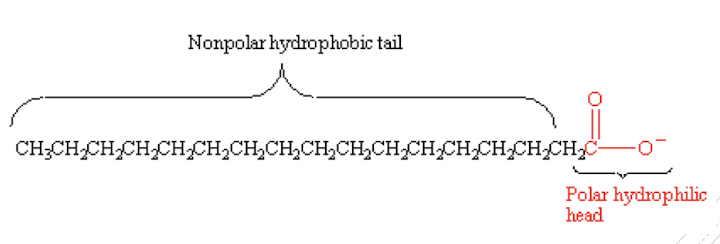
amphipathic/amphiphilic molecule
categorisation based on the length of hydrocarbon chain:
short-chain FA: ≤6 carbons
medium-chain FA: 8-12 carbons
long-chain FA: 14-18 carbons
very-long chain FA: ≥20 carbons
most commonly found: palmitic acid (16C) & stearic acid (18C)
categorisation based on the degree of saturation in the hydrocarbon chain:
saturated FA
unsaturated FA
Triglycerides (triacylglycerols)
consists of 1 molecule of glycerol esterified with 3 fatty acids molecules
present in dietary fat; synthesised in the liver & adipose tissue
Cholesterol
unsaturated steroid alcohol; amphipathic lipid (both hydrophilic and hydrophobic)
almost exclusively synthesised by animals
present in dietary fat; synthesised in liver
precursor of steroid hormones & bile acids; does not serve as a source of energy fuel
Lipoproteins
consists of a non-polar core triglycerides & cholesteryl esters
surrounded by a polar surface layer of phospholipids, cholesterol, & apolipoproteins
classification based on different density fractions after ultracentrifugation
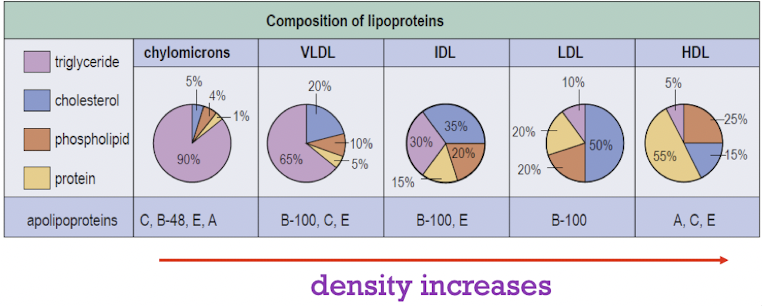
LDL - associated with increased risk of cardiovascular disease
Lipids/Lipoproteins Analyses
Dyslipidemias
diseases associated with abnormal lipid concentrations
cause:
genetic abnormalities
environmental/lifestyle imbalances
secondary to other diseases
defined by clinical characteristics & laboratory test results
laboratory analyses:
total cholesterol
HDL
LDL
triglycerides
clinical reference ranges for lipids

Cholesterol measurement
serum/plasma specimens are collected after fasting for at least 12 hours
serum/plasma specimens can be refrigerated at 4C for several days

HDL measurement
two-step procedure with manual pretreatment
precipitation reagent aggregates non-HDLs which are sedimented via centrifugation
HDL is then quantified by enzymatic assays
LDL measurement
via Friedewald calculation
total cholesterol, triglycerides and HDL are quantified
VLDL is estimated as [triglyceride level/5] in mg/dL unit
LDL = total cholesterol - HDL - VLDL
Triglyceride measurement
perform in conjunction with total cholesterol
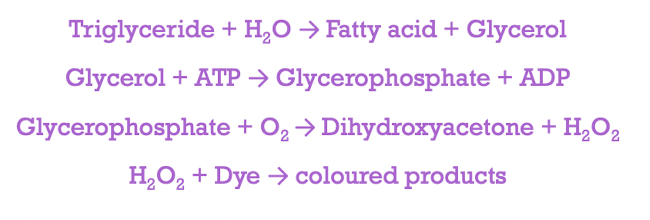
Lipid Disorders
Arteriosclerosis
deposition of lipids (esterified cholesterol) in artery walls
results in fatty streaks → plaques (smooth muscle cells, extracellular lipid, calcification & fibrous tissue) → partial or complete occulsion of blood flow
LDL → initiate & promote plaque formation
→ every 1% decrease in LDL concentration leads to 2% decrease in arteriosclerosis risk
Hypercholesterolemia
associated with genetic abnormalities [i.e., familial hypercholesterolemia (FH)]
homozygotes
total cholesterol ~800-1000mg/dL (20-26 mmol/L)
first heart attack in teenage years
heterozygotes
~300-600 mg/dL (8-15 mmol/L)
symptomatic for heart disease in 20s-50s
Hypertriglyceridemia
due to genetic abnormalities (e.g., FH)
consequence of secondary causes (e.g., hormonal abnormalities, diabetes mellitus or nephrosis)
imbalance between synthesis & clearance of VLDL
many coronary heart disease patients have moderately elevated triglycerides & decreased HLDL level
Summary (Part 1)
Different types of lipids
Laboratory analyses for lipids/lipoproteins
Development of arteriosclerosis
Carbohydrates
Large macromolecules containing C, H & O atoms
Generic formula:

Contain C=O and -OH functional groups
Grouping based on the number of carbon:
trioses (3C)
tetroses (4C)
pentoses (5C)
hexoses (6C)
Grouping based on the location of the C=O functional group
aldehyde group (O=CH-)
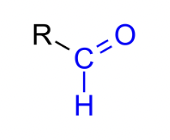
ketone group (O=C)
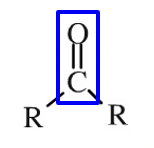
Saccharide - basic unit structure
Classification:
monosaccharide (e.g., glucose, fructose, galactose)
disaccharide (e.g., lactose, maltose, sucrose)
oligosaccharide (e.g., oligofructose, maltotriose)
polysaccharide (e.g., amylose, glycogen)
Glucose
Major energy supply
primarily stored as glycogen in liver & muscle
disease states:
hyperglycaemia
hypoglycaemia
Hyperglycaemia
hyper (high) + glykys (sweet/sugar) + haima (blood)
an increase in blood glucose level
defined as blood glucose level (>125mg/dL during fasting)
Causes:
reduced insulin secretion
decreased glucose utilisation
increased glucose production
Laboratory findings (blood specimen)
increased glucose level in plasma
increased serum osmolality
ketones in serum (ketonemia)
decreased blood pH (acidosis)
electrolyte imbalance
Diabetes Mellitus
metabolic disorder characterised by chronic hyperglycemia
arise from defects in the secretion, or action of insulin, or both
clinically defined as high plasma glucose concentrations at which there is an increased risk of retinopathy, nephropathy & neuropathy
type 1 diabetes mellitus
pancreatic islet B-cell destruction
tendency to ketoacidosis
type 2 diabetes mellitus
insulin resistance
insulin secretory defect
gestational diabetes mellitus
glucose intolerance
metabolic & hormonal changes during pregnancy
Laboratory diagnosis
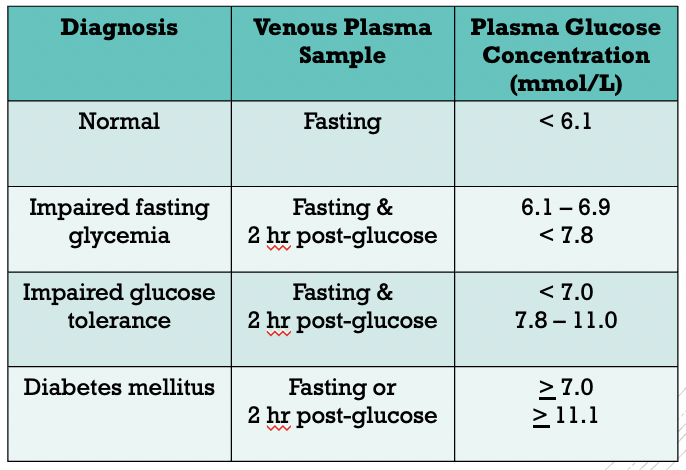
measurement of glycated haemoglobin
‘time-weighted’ average plasma glucose concentration over the past 2-3 months
in vivo glycation of haemoglobin is proportional to plasma glucose concetration
average plasma glucose concentration during the last 30 days accounts for 50% of the HBAlc concentration (glycated haemoglobin)
expressed as a proportion of total haemoglobin (in percentage)

Prediabetes
higher than normal blood glucose level, but insufficiently high to be considered as diabetes
increased risk of type 2 diabetes mellitus, heart disease & stroke
reversible
criteria:
126mg/dL > fasting glucose level ≥ 100 mg/dL
200mg/dL > 2hr OGTT level ≥ 140 mg/dL
HBAlc concentration of 5.7-6.4%
Glucose Assay
serum/plasma sample
enzymatic approach - glucose oxidase, hexokinase, glucose dehydrogenase
generate measurable coloured product proportional to glucose concentration
Glucometer
medical device for point-of-care measurement of blood glucose concentration
rapid & easy home-based blood glucose monitoring, particularly among individuals with Type 1, 2 & gestational diabetes mellitus
requires only a small amount of blood sample (from fingertip)
Hypoglycaemia
Blood glucose level is lower than the standard range
fasting blood sugar ≤ 70 mg/dL or 3.9 mmol/L
common among
particularly in type 1 diabetic patients
type 2 diabetic patients who are on insulin/medication
rare in individuals with normal glucose metabolism
diagnosis should be made only if the individual demonstrates:
hypoglycaemic symptoms
low plasma glucose concentration <50 mg/dL
symptoms are relieved by administering glucose/glucagon
Gestational Diabetes Mellitus
Recommendation: all nondiabetic pregnant women should be screened at 24-28 weeks of gestation
one-step approach: 2-hr oral glucose tolerance test (OGTT) by using 75g glucose load
requires overnight fasting of at least 8hr

Complete Blood Count
to evaluate overall health
to screen, diagnose & monitor certain health disorders, e.g., anaemia, infection & leukemia
Measurement and/or counting of:
red blood cells
white blood cells
haemoglobin
haematocrit
platelets
mean corpuscular volume (MCV)
Red Blood Cells
measure the number of red blood cells, which carry oxygen from the lungs to the rest of our body
normal count (male):
4.35-5.65 million cells/ul
normal count (female):
3.92-5.13 million cells/ul
increased level may indicate:
polycythemia
respiratory distress
high altitude
decreased level may be a sign of:
iron anemia
vitamin B12, vitamin B6 and/or folic acid anaemia
haemorrhage
liver & renal dysfunction
White Blood Cells
measure the total number of WBCs (without differential)
measure the number of each of the 5 basic white blood cell types (differential)
neutrophils, eosinophils, basophils, lymphocytes & monocytes
expressed as percentage or absolute value
elevated white blood cells count may indicate inflammation or infection
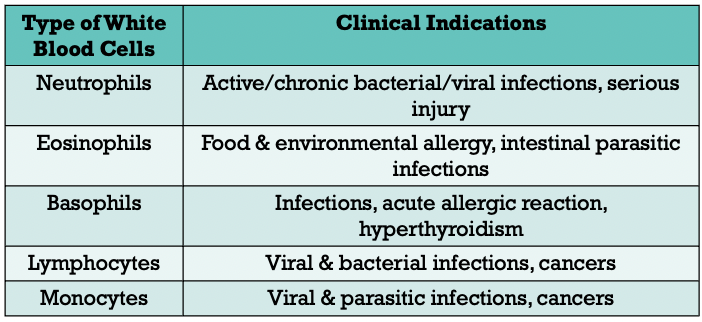
low cells count may indicate autoimmune diseases, bone marrow disorders or cancers
normal: 3.49-9.6 billion cell/litre
Haemoglobin
protein that carries oxygen in the red blood cells
normal (male): 132-166 g/L
normal (female): 116-150 g/L
increased level may indicate dehydration, emphysema, asthma, polycythemia
decreased level may indicate iron deficiency anaemia, microscopic internal bleeding, digestive inflammation
Hematocrit
known as packed cell volume
percentage of the total occupied by packed red blood cells when a given volume of whole blood is centrifuged
normal (male): 38.3% - 48.6%
normal (female): 35.5% - 44.9%
abnormal value indicates the similar clinical conditions as haemoglobin
Platelets
responsible for blood coagulation and vascular integrity
reference (male): 135-317 billion/L
reference (female): 157-361 billion/L
increased level: atherosclerosis, rheumatoid/inflammatory arthiritis, certain cancers
decreased level: idiopathic thrombocytopenia, blood loss
Means Corpuscular Volume (MCV)
the volume in cubic microns occupied by an average single red blood cell
↑ level (macrocytic RBCs): vitamin B12/folic acid anaemia, dehydration
↓ level (microcytic RBCs): iron anaemia, microscopic internal bleeding
other RBCs-related markers:
MCH (mean corpuscular haemoglobin)
MCHC (mean corpuscular haemoglobin concentration)
Summary (Part 2)
Hyperglycaemia and hypoglycaemia
complete blood count & its clinical indications
 Knowt
Knowt